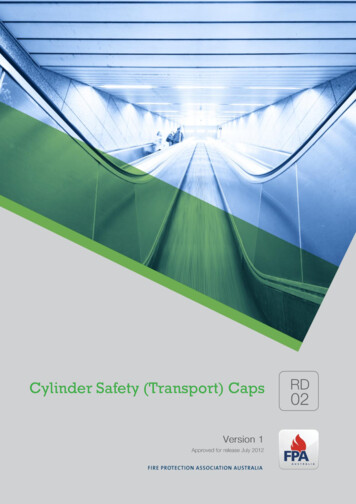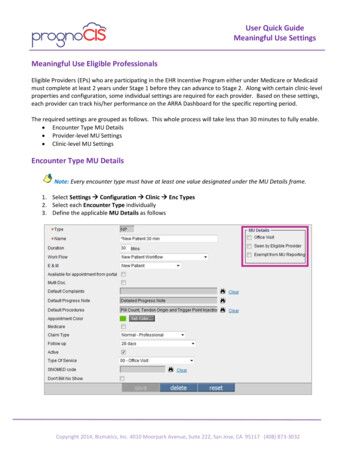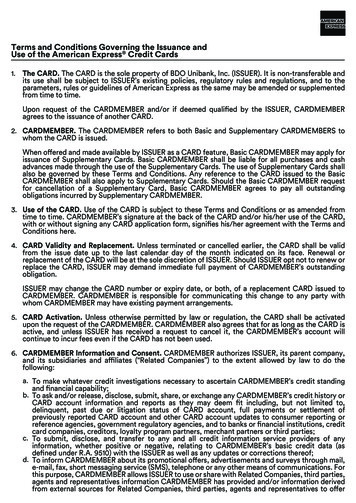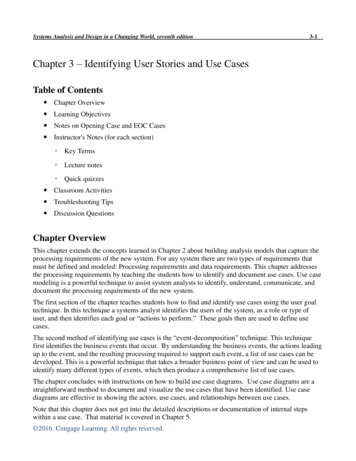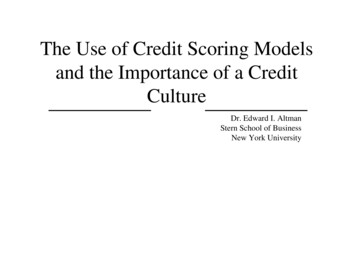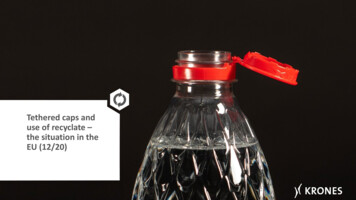
Transcription
Tethered caps anduse of recyclate –the situation in theEU (12/20)
2 Tethered caps and use of recyclate – the situation in the EU (12/20)Contents1. Initial situation2. Core content of the EU directives1. Recyclate percentages and collection rates2. Connected caps: “Tethered caps”3. Tethered caps: What variants are available?4. Tethered caps: Anticipated costs5. National implementation of the EU directive6. Conclusion
3 Tethered caps and use of recyclate – the situation in the EU (12/20)1. Initial situationPlastic is facing increasing criticism particularly, though notexclusively, due to its use in packaging. The mass of man-madearticles is currently beginning to exceed the biomass on ourplanet.1 One of the most visible consequences of this is the wastepollution in our environment and oceans.To tackle this problem, private initiatives have been created onthe one hand, such as the internationally established EllenMacArthur Foundation.2 On the other hand, legislators are alsointroducing appropriate measures. In the EU, such measures arecombined in the SUP (Single Use Plastic) EU Directive 2019/204.3Erik Stokstad (2020): “Human ‘stuff’ now outweighs all life on Earth”. f-now-outweighs-all-lifeearth?utm source Nature Briefing&utm campaign 4b1a5638bc-briefing-dy-20201210&utm medium email&utm term 0 c9dfd39373-4b1a5638bc-451070782 https://www.ellenmacarthurfoundation.org3 https://eur-lex.europa.eu/eli/dir/2019/904/oj1
4 Tethered caps and use of recyclate – the situation in the EU (12/20)2. Core content of the EU directiveIn addition to reducing consumption (Article 4), a ban on certaindisposable plastic articles, including cotton buds made of plastic(5), and the manufacturer having to take on more responsibility(8), there are two points which are of particular interest toproducers and distributors of beverage packaging.Specific product requirements are set out in Article 6 andcollection rates in Article 9:Article 6 in more detail:First of all: The prescribed minimum percentages of recyclateSecondly: Design of the container closure system as a “tetheredcap”
5 Tethered caps and use of recyclate – the situation in the EU (12/20)2.1 Recyclate percentages and collection ratesThe EU timetable envisages an increase in the percentage ofrecyclate contained in plastic beverage bottles (Article 6). Thecollection rates for plastic waste originating from non-returnableplastic articles should also increase (Article 9):As of 2025As of 2030Recyclate percentage25 percent30 percentCollection rate*77 percent90 percent*The collection rate is currently approximately 55 percent.These percentages refer to the overall market of the respectivemember states, meaning they need to be reached in everymember state, not simply as an EU average.KRONES is in a good position to achieve this: A recyclatepercentage of 100 percent is easily manageable with an adequatematerial quality. Many of our customers are already using it todayfor individual product lines.However, the availability of recyclate of adequate quality isproblematic here. The system covering the collection of usedcontainer packaging needs to catch up with demand and it is alsohere that the measures indicated in Article 9 need to beenforced. However, collection improvements are currently beingplanned and corresponding legislation is being introduced invarious member states.4 Companies that wish to determine thequality of their recyclate themselves are well advised to choose arecycling system from KRONES.5Take the introduction of bottle deposit systems in Slovakia for example: html5 ons/pet-recycling-systems.php4
6 Tethered caps and use of recyclate – the situation in the EU (12/20)2.2 Connected caps: “Tethered caps”To ensure that the closures on beverage containers no longer getlost so easily and end up as waste in the environment, as of 2024they will have to remain connected (tethered) to the packagingonce opened. Precise regulations are currently being drawn upregarding the technical design of these caps. The Europeancommittee for CEN standardisation and the internationalassociation CETIE are the main bodies being employed to do so.6See here for example: rtAs a supplier of technology to the industry, KRONES is currentlyworking on these issues as part of the CETIE team – even if we donot supply any bottle caps or cap tools ourselves. We also work inclose collaboration with a number of different capmanufacturers.6From a (mechanical) engineering viewpoint, a variety of tetheredcaps are permitted as a general rule.
7 Tethered caps and use of recyclate – the situation in the EU (12/20)3. Tethered caps: What variants are available?Generally speaking, tethered caps can be split into two groups:flip-top caps and screw caps.Flip-top caps – also known as flip lids, flip tops or thumb-ups –have a design which keeps them permanently connected to thebottle right from the outset. They are normally suitable for noncarbonated beverages or low internal container pressures.
8 Tethered caps and use of recyclate – the situation in the EU (12/20)3. Tethered caps: What variants are available?In contrast, with today’s screw caps, the connection between thecontainer and the cap is broken when used correctly. However,screw caps are needed to seal bottles above a certain bottleinterior pressure. This means that the cap can only stayconnected to the container if an additional feature is included.The outer contour of the cap may have a rotationally symmetricalexterior shape in both options, so that the cap can beaccommodated in the cap retainers usually found in today’scappersThe shape can also deviate from a rotationally symmetrical roundshape, for example due to hinge designs. In such cases, specialgripper heads must be used in the closer. KRONES offers just theright sorting and capping technology for every variant.
9 Tethered caps and use of recyclate – the situation in the EU (12/20)4. Tethered caps: Anticipated costsFrom a recycling viewpoint, the use of tethered caps is notaccompanied by a great number of changes. This is because thePET fraction, i.e. the bottles, and the PE fraction, meaning thecaps, are run through a mill before separation. The mill grinds upthe material and, even today, already separates any cap tamperevident bands remaining on the bottles.Many of the cap solutions currently in development are based onthe neck finishes established on the market today, for examplethe PCO 1881. For beverage system operating companies, thismeans that there is a good chance that a change-over to tetheredcaps can go ahead with a relatively low investment. At least ifother characteristics do not need to be changed as well – forexample a reduction in the neck or bottle weight.Major investments will need to be made in the field of capmanufacturing or the required tool technology.What is to be viewed negatively here is the investment to bemade for this conversion and the additional limitation regardingthe reduction of packaging weights, which will obviouslyaccompany this additional technical requirement.
10 Tethered caps and use of recyclate – the situation in the EU (12/20)5. National implementation of the EU directiveHowever, it is still important to be aware that the regulationsprescribed in the EU directive are stipulated for the EU memberstates. The member states still have to turn this stipulation intonational law. As a result, the individual configuration could varyfrom country to country. This could then in turn lead to nationallaws and regulations that are in line with the EU directivedeviating from the EU stipulations and being configured to beeven stricter than the EU directive 9/210720-euco-final-conclusions-en.pdfOne possibility is, for example, that to achieve an averagerecyclate content of 30 percent of the national market, it is madeobligatory for every PET bottle brought into circulation.This is a similar situation to the one with the EU “plastic tax”introduced a short while ago, which will cost the member states800 euros per tonne of non-recyclable plastic, but which mayinvolve completely different laws on a national level.7
11 Tethered caps and use of recyclate – the situation in the EU (12/20)6. ConclusionAll things considered, one must admit that the implementation ofthe respective EU directive is sure to create costs due to thenecessary measures. These measures have, however, alreadybeen approached in the industry and a rule-consistentimplementation of this directive is sure to be basically possible.What remains therefore is the legitimate hope that these changeswill actually result in a reduction in the amount of plastic wasteintroduced into our environment.If you have any questions on this issue, please feel free tocontact:Jochen ForsthövelPhone: 49 9401 70-1804E-mail: jochen.forsthoevel@krones.com
We do more.
Flip-top caps – also known as flip lids, flip tops or thumb-ups – have a design which keeps them permanently connected to the bottle right from the outset. They are normally suitable for non-carbonated beverages or low internal container pressures.


